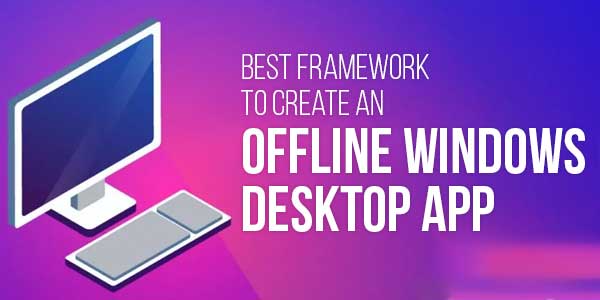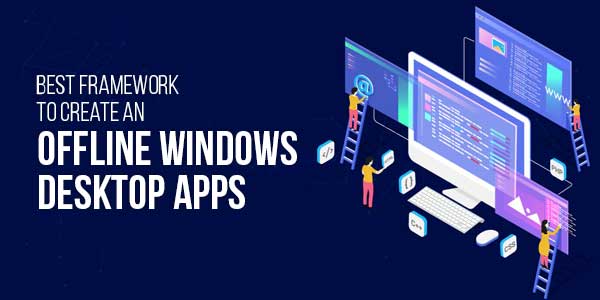
Table of Contents
Best Framework To Create An Offline Windows Desktop App
In today’s increasingly web-focused world, offline Windows desktop applications still hold significant value for businesses and developers. Whether you need robust performance, enhanced security, or seamless operation without internet connectivity, choosing the right framework is crucial for your project’s success. This comprehensive guide explores the top frameworks available in 2024 for building powerful Windows desktop applications.
“Desktop applications continue to dominate enterprise environments where reliability, performance, and offline capability are non-negotiable.” – Microsoft Developer Blog
Why Choose Desktop Applications Over Web Apps?
Before diving into frameworks, let’s understand why desktop apps remain relevant:
- Offline Functionality: Work seamlessly without internet connectivity
- Superior Performance: Direct hardware access enables faster operations
- Enhanced Security: Reduced exposure to online threats
- Native Integration: Better compatibility with Windows features
- Rich User Experience: More responsive and interactive interfaces
Top Frameworks For Windows Desktop Application Development
1. Windows Presentation Foundation (WPF)
Microsoft’s flagship framework for building Windows desktop applications continues to be a top choice for developers. WPF uses XAML for UI design and integrates seamlessly with the .NET ecosystem.
Key Features:
- Advanced data binding capabilities
- Hardware-accelerated rendering
- Rich styling and templating options
- DirectX integration for graphics-intensive applications
For complex enterprise applications requiring deep Windows integration, WPF remains unmatched. Learn more about Windows application development on our dedicated guide.
2. Universal Windows Platform (UWP)
While primarily designed for universal apps, UWP can create excellent offline desktop applications with modern UI/UX capabilities.
Advantages:
- Single codebase for multiple Windows devices
- Modern Fluent Design System
- Built-in support for touch, pen, and voice input
- Automatic updates through Microsoft Store
3. Electron
The popular framework for building cross-platform desktop apps using web technologies (JavaScript, HTML, CSS) has gained significant traction in Windows development.
“Electron democratized desktop development by allowing web developers to create native applications using familiar technologies.” – GitHub Engineering Team
When To Choose Electron:
- You need cross-platform compatibility
- Your team has strong web development skills
- Quick prototyping is required
- The application doesn’t demand maximum performance
Explore our comparison of native vs cross-platform development approaches for more insights.

4. .NET MAUI (Multi-platform App UI)
As the evolution of Xamarin.Forms, .NET MAUI provides a modern approach to building native desktop applications that can also target mobile platforms.
Notable Benefits:
- Single project structure for multiple platforms
- Access to native APIs through dependency injection
- Hot Reload for faster development cycles
- Built-in support for MVVM pattern
5. Qt Framework
For performance-critical applications requiring native C++ power, Qt remains a premier choice among desktop developers.
Qt’s Strengths:
- Exceptional performance for resource-intensive apps
- Extensive library of UI components
- Strong cross-platform capabilities
- Excellent documentation and commercial support
Comparative Analysis Of Windows Desktop Frameworks
Choosing between these frameworks depends on several factors. Here’s a quick comparison:
| Framework | Language | Performance | Learning Curve | Best For |
|---|---|---|---|---|
| WPF | C#/XAML | High | Moderate | Enterprise Windows apps |
| UWP | C#/XAML | High | Moderate | Modern Windows apps |
| Electron | JavaScript | Medium | Low | Cross-platform web-like apps |
| .NET MAUI | C#/XAML | High | Moderate | Multi-platform business apps |
| Qt | C++/QML | Very High | Steep | High-performance applications |
Key Considerations When Choosing A Framework
Application Requirements
Define your application’s core needs before selecting a framework. Consider:
- Performance requirements
- Offline data storage needs
- Hardware integration level
- Future scalability
Development Team Expertise
Leverage your team’s existing skills for faster development:
- C# developers might prefer WPF or .NET MAUI
- Web developers may find Electron more accessible
- C++ teams can maximize Qt’s potential
Long-Term Maintenance
Consider the framework’s:
- Community support and size
- Update frequency and roadmap
- Available talent pool for future hires
Our guide on desktop application maintenance provides additional insights on this crucial aspect.
Emerging Trends In Windows Desktop Development
WebView2 Integration
Microsoft’s WebView2 control allows embedding modern web content in desktop applications, combining the best of both worlds.
Progressive Web Apps (PWAs) As Desktop Apps
PWAs installed as desktop applications offer a lightweight alternative for certain use cases.
AI-Enhanced Development
Tools like GitHub Copilot are transforming how developers build desktop applications.
Conclusion: Selecting The Right Framework
Choosing the best framework for your offline Windows desktop application depends on multiple factors. For pure Windows applications requiring maximum performance and integration, WPF remains the gold standard. Cross-platform needs might lead you to Electron or .NET MAUI, while performance-critical applications could benefit from Qt.
Remember that the “best” framework is the one that aligns with your project requirements, team skills, and long-term maintenance strategy. Evaluate each option carefully, prototype if necessary, and make an informed decision that will serve your application well throughout its lifecycle.
For more insights on application development, explore our software development guides collection.


















Be the first to write a comment.